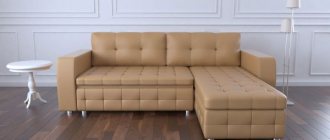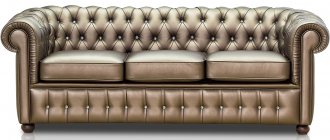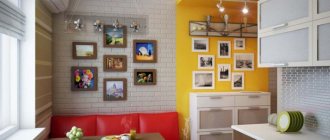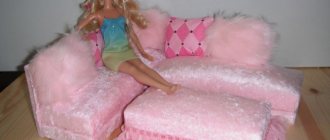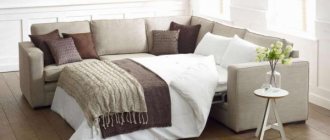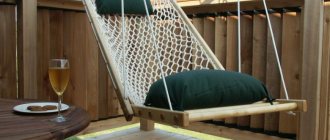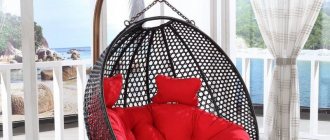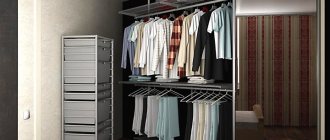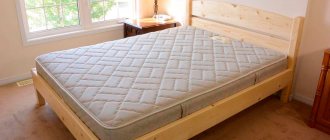Upholstered furniture is a necessary piece of furniture in every home. The opportunity to expand the functionality of a sofa in the living room by using it as a sleeping place is always welcome, especially for owners of small apartments. Having the desire, a small budget and knowing how to handle carpentry tools, you can make a comfortable folding sofa with your own hands.
Making a sofa yourself is not the easiest task, requiring attentiveness and accuracy, but it is quite doable. Images, diagrams, drawings of both the entire product and its individual elements will help with this. In this case, you should carefully consider the future folding mechanism and take into account its operating and installation features when creating a sofa. Today there are many ways to transform a soft sofa in the living room into a full-fledged sleeping place. For example: book, eurobook, roll-out, “click-click”, “dolphin”, etc.
What solid material are bedrooms made from?
- Headsets made from birch are often found on sale. This wood, similar in its characteristics to beech, is easily glued, stained and polished, resulting in a wide variety of furniture shades. Products made from Karelian birch have a unique pattern, and sometimes look as if they were made of marble. Birch is often used to produce veneer.
- Bedroom furniture made from solid pine is very popular. This material has many different shades.
- Oak is a very hard and durable tree. Furniture made from it can last for many years and even decades. Such sets also have enough shades: from light yellow to yellowish-brown. If you look hard enough, you can find bedroom furniture made from solid wood in gray or even green tones.
Oak products lend themselves well to painting, drying and varnishing. It is quite difficult to split such wood, and even more difficult to carve. In addition, the workpieces bend well, can be sanded without problems and can be drilled well.
Beech is inferior in strength and hardness to oak, but not by much. At the same time, beech wood is very plastic. The color range is quite wide: from pink-yellow to reddish-brown. Wood is rarely used as veneer; it is more practical to produce products from solid wood.
Bent furniture pieces are most often made from this type of wood, since its wood is easily processed and tolerates painting and bleaching, sanding and tinting well. The advantage of beech compared to oak is that furniture made from it is somewhat cheaper.
Larch is distinguished by its extraordinary hardness and is used not only for the manufacture of furniture sets, but also for various types of finishing materials. This tree is famous for containing many biologically active compounds that are very beneficial for human health. People who have such furniture in their bedroom are less susceptible to colds and viral diseases - thanks to the phytoncides released by wood. As for the shades of larch, there are 12 of them.
- Pine, unlike larch, is a very soft tree. It doesn't cost anything to accidentally scratch such furniture. Despite this, light pine sets are deservedly popular among the population, mainly due to their pleasant pine aroma. In addition, this wood resists moisture, temperature changes and microorganisms well.
- Linden wood is very durable and at the same time plastic, well suited for making carved furniture. Linden products are not very convenient to paint - this material has poor permeability. But if you cover pieces of furniture with stain, you get shades characteristic of valuable types of wood.
Linden is not very resistant to pest infestation, and it cannot be done without treatment with special compounds.
- Cherry can easily be classified as an elite type of wood. It is quite simple to process and can be easily varnished. Truly luxurious products are made from it, which look great in combination with carvings and glass. Over time, such solid wood bedroom furniture takes on a darker shade.
- Sets made of maple are rarely made. The fact is that such wood weighs quite a lot, it is very dense and durable. But maple is used quite often as veneer in the processing of expensive furniture. This is especially true for Canadian maple, which has a unique and very attractive texture.
- Cedar has a low density, is resistant to moisture and is practically not afraid of microorganisms. All these qualities make it indispensable in the production of furniture intended for rooms with high humidity - for example, saunas. Furniture made from this type of wood is quite rare in houses or apartments.
About cutting and sewing
The most difficult and responsible part of the work of making a sofa is its stuffing, upholstery and upholstery. These are different manufacturing operations; each of them separately and all of them together determine the consumer qualities of the product and its durability more than woodwork. True, craftsmen are actively promoting themselves on the RuNet, promising to reupholster a sofa in an hour or even 20 minutes, but, firstly, they work mainly with non-woven materials (fleece, etc.), which in themselves are short-lived. Secondly, they are covered using a simplified system with the corners turned inside out, which is unhygienic and guarantees rapid abrasion of the covering. And most importantly, with this method of work there is no reliable information about: a) the durability of the product before the need for reupholstery; b) whether any of the primary clients contacted this specialist again.
To properly sew covers for sofa modules, serious preparatory work will be required. Its essential subtleties will be described below; Beginners are advised to upholster a sofa using the old amateur method with saddle stitch fitting. The pros don't do much work for them, because... it takes a lot of time, and who will pay for it? But during the heyday of stagnation (or stagnation of heyday?), when you had to sign up for furniture reupholstery a year in advance, and even give a bribe, it was successfully used by “complete dummies.” The sofa is covered step by step like this:
- The wooden base is covered with technical fabric - canvas, matting, burlap (possibly propylene);
- Install soft padding, most often foam mats;
- They cover the soft material, in order of preference, with spandbond, padding polyester, or batting;
- On a piece of decorative fabric, the drawstrings are swept under the cords, if decorative scars/straps are provided, see below;
- The decorative cut, without cutting, is thrown over the product with the wrong side out, pulled in as described below, and the corners are swept away with a harsh thread (now reinforced with propylene) with the scar facing out;
- After a day, check to see if the pattern is wrinkled, sagging, or distorted, especially geometric ones, and if necessary, adjust the angles;
- If everything is OK, mark the seam lines, cut and sew;
- Tighten the cords into the drawstrings for tightening, if necessary;
- Throw on the cover, make the final tightening, starting from the corners;
- After another day, check the drawing and adjust the tension threads;;
- Everything is OK – the lapels are secured;
- Decorative ties are formed.
The procedure, as we see, is quite complicated and lengthy. This is explained by the fact that the properties of fabrics, incl. upholstery, vary noticeably within a piece. Previously, upholsterers were guided by intuition and experience; now the technical parameters of a particular sample are directly entered into professional computer cutting programs. Homemade templates from wallpaper newspapers do not provide this and do not take into account the initial tightening of the fabric. However, it is useful to make them - to determine the fabric consumption. A rough estimate of the method: the length of a cut with a width of 150 cm is equal to 2 widths of the sofa + 2 its lengths, gives a large waste. Determining the length of the cut using templates (allowance from 15 cm) saves lengths of up to 1 m (!); how much is it in money - see in the store.
Note: for the same reason, if you are reupholstering a sofa, it is not advisable to use old upholstery as a pattern. Under a microscope or magnifying glass, it is clearly visible that the structure of its fabric has changed significantly compared to the same jacquard or tapestry from the same loom.
Scheme of stuffing upholstered furniture with a spring block
Paragraphs also require additional clarification. 1-3. If you stuff the skin hastily, wood-glue-sintepon-foam-rubber-decor, then after a while you will find that the skin is greasy, sticky to the touch, especially in summer, and the dearest parts of the body feel uncomfortable on it. Let “some” be 3 years, but what kind of lifespan is this for furniture? Therefore, soft padding mats need porous pads on both the bottom and top to remove evaporation/sweat/dirt from them. In furniture with spring blocks, by the way, too, see fig.
We also recommend following the link for more information about sewing sofa covers yourself.
Schemes and drawings
There are a variety of sofa designs, as well as shapes and upholstery methods.
Main components:
- back;
- frame;
- frame;
- fabric lining;
- sides.
Frame. For assembly, slats and bars are used. For greater rigidity, plywood sheets or fiberboard are used.
The back is made hollow inside. The shape most often chosen is sloping or rectangular. The side elements are made in the same way as the back.
Fabric lining is made using ready-made patterns or patterns. If they are not there, then you can make the drawings yourself. For this purpose, the facing material is applied to each part of the structure, then the necessary cuts are made.
Attention! When making a round sofa, furniture panels are used, which are made of wood or plywood sheets. This material allows the round structure to withstand sufficient load
What about simpler?
As you can see, making and upholstering a sofa is not a big deal. Isn’t it possible to do something quicker and simpler here, to the dacha, to a new apartment? To throw on any pillows and collapse?
Sofas made from pallets
You can, the solution is called a sofa made of pallets. In general, a lot of things are made from construction pallets - pallets, including furniture, because pallets are inexpensive, seasoned wood of excellent quality.
The main thing here is taste and ingenuity. The simplest, most primitive garden sofa stack from pallets can be made much more convenient by using the principle of an Adirondack-type garden chair, on the left in Fig. It’s a little more difficult to use them to build a rustic-style pull-out sofa bed in the center. And if you press harder (with a tool, not a glass), you can get a sofa that you can’t immediately tell is from a discarded container, on the right. For example, see what a sofa was made by a seemingly completely inexperienced, but not at all stupid and not armless guy:
Video: DIY pallet sofa
Types of beam connections
When constructing a log house, it is necessary to connect individual elements when crossing at an angle or when the elements are not long enough. Several types of connections are used.
The most popular and convenient connections are with or without residue, in a cup or in a tooth.
Connection with remainder
One way connection. One side of the beam is sawed across the element, the width of the notch is equal to the width of the attached element. This is the simplest and most commonly used method.
The connection of beams with the rest is used more often than others, and the fastening of such beams is more reliable. Source pinterest.ru
A double-sided lock requires making cuts at the top and bottom of the block. Their depth is a quarter of the thickness of the element. The use of this technology creates a high-quality connection, but will require the work of experienced carpenters.
The four-way connection is the most complex and the most reliable and accurate. The cuts are made on all sides of the block. The building is assembled like a construction kit - quickly and efficiently. In this case, all dimensions must be strictly observed, the cuts are made strictly at right angles.
Connection without residue
This type has many options. Here are the frequently used ones.
Butt connection. It is carried out using studded metal plates, they are secured with nails or staples. For this purpose, connecting dowels are also used, which secure the joint well, preventing the beams from moving and turning.
In this case, it is necessary to use additional fastenings, otherwise the house may move to the side. Source orpro.ru
It is good to use a tenon connection. The spike can be shaped like a triangle or trapezoid. The root thorn is popular. A groove is cut out on one of the beams, a tenon of the appropriate size is cut out in the other. With this connection, you can use insulation made from vegetable felt or jute fiber.
What you need to know before you start
First, keep in mind that even though sewing machines and other handy sewing accessories are available, it is important to understand that most of the work will have to be done by hand. Therefore, you need to be able to sew heavy fabrics and make patterns yourself. If you don't know how to do this, you'll have to learn
If you don't know how to do this, you'll have to learn.
However, there is a way to simplify the learning process - if you bought a cover for the sofa a long time ago, then you can tear it into separate parts and apply it to the existing fabric. However, often this is not possible. In this case, you will need to learn from video lessons on the Internet - fortunately there are a lot of them now.
You can make a cape with or without armrests. In the latter case, the process is much simpler, which will greatly help beginners. This option is well suited for country houses.
Stage 1: Frame
We make two frames from wooden blocks with a cross-section of 10x5 cm. You can use wood glue or corners as fastening material.
We install spacers (from 1 to 4 pieces) into the frame. Their task is to compensate for the load.
We screw the fences to the frame. It is better to use boards with a section of 15x2 cm (lower tier) or 20x2 (upper) as sides. Fastening is carried out with self-tapping screws, screwing them in from the inside.
We fasten two bars with a cross-section of 10x5 cm and a height equal to the height of the structure together with the fences in pairs to form a profile in the shape of the letter L. We recess the self-tapping screw into the wood, and putty the resulting recesses and sand them.
We make holes for screws in the supports and frames. To prevent the structure from falling apart, we fix it on the wall. To do this, we screw the upper level to the racks, along which we mark the location. We start drilling only after careful measurements.
How to sew a cover
Making the body of a sofa is already a lot, but it is also important to trim it beautifully. Considering the fact that the fabric is expensive and cannot be bought in reserve, it is important to make the right patterns and sew a cover from them
Which fabric to choose?
Depending on where and under what conditions the sofa will be used, a suitable fabric is selected. Let's look at a few examples.
Where is the sofa located Type of fabric In the living room, the sofa is often used, and not only by people living in the apartment. Guests often sit on it during meals, so there is a high probability that a cutlet or a piece of fish in vegetable oil will fall on it
Taking this into account, it is better to use synthetic fabrics, since they practically do not absorb moisture, including fats, and wash well. In the bedroom, a sofa is used to sleep on it or just relax. Instead of synthetic fabrics, it is better to use natural materials, or those containing at least 50% natural fibers
Flock is often used, as this type of fabric is durable, does not cause allergies and does not lint. Concerned about the health of the child, it is better to use cotton fabrics that do not cause allergies. This type of cladding has one significant drawback - it gets dirty easily, which makes it impractical. You can improve the quality of the fabric by using Teflon impregnation. In the area of regular eating, there is a high probability of contamination of the sofa upholstery with food products. Using fabric is impractical and unprofitable, so it is better to use high-quality leatherette, which is made specifically for these purposes. Low-quality leatherette will very soon begin to peel off from the base.
How to cut
When repairing an old sofa, you can use the removed fabric as a pattern, but when upholstering a new sofa you will have to cut it yourself. How to make the right pattern?
Covering with a single piece of fabric
This technology has already been briefly mentioned in the article, but now we will describe the entire process in detail. For example, we will use a sofa seat and instead of a single piece of fabric, we will demonstrate it using a piece that was left after sewing the cover.
So, in order to upholster a separate element of upholstered furniture, you need to cut a piece of fabric that could be used to wrap the piece so that the edges can be secured from below.
Having stretched the fabric onto the parts, it needs to be stapled in front and behind. Then the hanging corner at the front is pulled tight and secured at the bottom. The fabric is laid out in folds so that they converge at one point and nailed with staples.
The back of the seat will be turned towards the wall, so you can not lay it out, but simply fold it, leaving the excess inside, and secure it in this state.
Sewing a cover for a non-folding sofa
The described technology will allow an inexperienced person to cut and sew a cover not only for a new, but also for an old sofa.
Sewing this cover took 3.5 meters of fabric and a spool of thread.
So, you need to throw the fabric over the sofa, wrong side up, positioning it in the same way as the finished cover will be located.
We will put marks so that we can then cut the fabric according to them.
In these places we cut the fabric all the way to the sofa.
The seat piece needs to be fastened to the back fabric.
Using needles, you need to pin the fabric along all the supposed seams. Instead of needles, you can use pins or sew with a basting stitch.
Next we apply the future frill, which will be gathered into folds.
Having fastened all parts of the cover, remove it.
After basting the seams, put the cover on the sofa - it should fit without much effort, fitting the product being covered. If it turns out to be too tight or too loose, then this needs to be corrected by removing it.
Now you can sew the cover.
Then a frill is sewn onto it. If the cover is intended for upholstery of a sofa, then there is no need to sew on the frill, as it will be inconvenient to fix the fabric. The frill can be nailed on later if the need arises.
The result is such a cute sofa. Based on this example, you can cover any sofa, but for a new one it is better to sew separate covers for the back and seat.
As you can see, making a sofa and upholstering it at home is quite possible.
How is the distance between joists calculated?
The pitch of the beams is calculated from the middle to the middle of the wooden support.
The beams serve as support for the material that will be used as flooring, and everything that will stand on the latter and those who will walk. The more often the bars are placed, the greater the load the floor surface can withstand. Therefore, when calculating the lag step, ideally the following factors should be taken into account:
- load per unit floor surface area (static, dynamic);
- the width of the log itself;
- thickness and strength of the flooring material.
The first two indicators are taken into account only in the case of a non-standard expected load or an unusual cross-section of the beams. The third factor plays a much larger role. The distance between the bars directly depends on the thickness of the flooring.
Nowadays, plywood or OSB boards are often used as starting flooring. In this case, taking into account the small thickness, and therefore the strength of the material, the pitch of the timber is made minimal (no more than 300 mm). When using floor boards, the distance between the joists is directly proportional to the thickness of the flooring. The thinner the board used, the smaller the pitch. The recommended distance is shown in the following table.
| Floor board, thickness | Beam pitch |
| 2 cm | 300 mm |
| 3 cm | 500 mm |
| 3.5 cm | 600 mm |
| 4 cm | 700 mm |
| 4.5 cm | 800 mm |
| 5 cm | 1000 mm |
Since the thickness of a modern floor board varies between 2-3 cm, then, accordingly, the pitch of the timber is calculated from 300 to 500 mm.
When calculating the number of logs required for one separate room, two points should be taken into account:
- the beams are installed perpendicular to the main light rays so that the seams between the floor boards stand out minimally;
- the outer support beam is attached 20-25 cm from the wall.
Taking these points into account, calculating the pitch of the supporting wooden beams will not be difficult.
Selecting consumables
Before starting any independent work, you should decide on the shape and size, as well as choose consumables for making furniture. These can be a wide variety of devices:
- Wooden pallets. Garden sofas made from wooden pallets are widely popular among avid summer residents and lovers of summer outdoor recreation. Such models are sufficiently durable, easy to assemble (according to a pre-prepared diagram), and do not require special practical care. And the convenient shape and mobility of the pallet parts allows you to make an excellent corner sofa.
- Plywood sheets are another affordable material. It is durable and is a good basis for subsequent decorative processing.
- PVC pipes left over after a major renovation can also be used to make a durable furniture frame. This sofa is quite compact, does not have significant weight, and therefore can be installed on the balcony.
In practice, you can even find a homemade sofa made of cardboard. In most cases, all you need is the skill and skillful hands of the owner of the future sofa.
An equally important part of the work is the preparation of the soft part, and, accordingly, the choice of fabric base, filler, and cover. As a rule, there are two covers: an internal one for the filler, and an outer removable casing.
Fillers that hold the shape of the body are quite expensive, and therefore you can give preference to the most ordinary polyurethane foam, padding polyester, or holofiber.
For covers, it is better to use combined fabrics made from a mixture of natural and artificial fibers. They withstand frequent washing, are not afraid of detergents, and do not lose their appearance or color.
Choosing the thickness of timber for building a house
The range of standardized timber sizes has the following values: 100, 150, 200, 250 mm. The main requirement when determining the thickness of the walls of a house is that it must impart a certain strength to the structure and have sufficient heat capacity to create a favorable climate in the house.
To determine which timber is better for a house, 150 or 200 mm, you should know what kind of house you will be building. For a one-story building, a thickness of 150 mm is sufficient. If exterior finishing or wall insulation is also done, then this is certain.
Two-story buildings require a stronger and more rigid structure. In this case, a section of 200x200 mm will be justified.
To build a house for seasonal residence in a country house or a bathhouse, if they are not insulated, use timber with a cross-section of 150x150 mm.
For such a house, for temporary residence, a simple beam of medium thickness is enough. Source domasibiri.com
If you build a residential building for permanent residence of people, it will have to be heated. The walls of such a cobblestone house must be insulated, otherwise it will not meet modern energy saving requirements.
It is known that the thermal conductivity of wooden walls depends little on their thickness. The difference between walls of 150 and 100 mm of timber will be 12% of heat. From this we conclude that insulated walls can be made thinner.
How can different types of timber differ:
Device and dimensions
The sofa consists of a supporting (load-bearing) structure, most often including a drawer, a bed - a sofa, if there is a lifting drawer, a backrest and armrests. In transformable products (sofa bed), a transformation mechanism and, possibly, additional pillows stored in a drawer are added to them. Typical sofa sizes:
- Length – 1200-1900 mm.
- The width of the sofa is 550-700 mm.
- The height of the armrests is from 100 (ottoman) to 400 mm.
- Back height, without extras. pillows – 200-700 mm.
- Backrest tilt – 5-20 degrees.
- The height of the “sitting” surface of the sofa above the floor is 400-450 mm.
The last parameter, in turn, consists of:
- Legs – 50-70 mm.
- Support frame – 50-100 mm.
- Box – 150-250 mm.
- The bottom of the sofa (with frame) is 55-75 mm.
This leaves up to 120 mm for soft padding with sheathing. If its thickness exceeds 70 mm, the sofa is considered soft, 40-70 mm - semi-rigid, up to 40 mm - hard.
What to consider when choosing timber: basic rules
Using the right material is the key to successful construction. This also applies to wooden structures.
What we first pay attention to when purchasing it:
Decide in advance what type of timber to build the house from. A one-story house needs enough material with a cross-section of 150x150 mm. When erecting two-story structures, use 200x200 mm timber. In the country version, use simple planed timber, pre-dried naturally. A residential building requires glued laminated structures
A timber with a profiled joint, dried in a chamber, is suitable. Attention should be paid to the quality of the product; it must have the correct symmetrical cross-sectional shape, there should be no irregularities or curvature. Choose variety A or AB. Use D profile beams instead of rounded logs.
Types of profiled timber for a country houseSource kebyx.moketa.ru.net
Benefits of homemade furniture
The obvious advantages of building home sofas include:
- Significantly lower financial investment. Most supplies can be found in your own pantry or garage.
- A large selection of ready-made plan projects and step-by-step instructions available for review. In addition, a huge collection of video tutorials on furniture making is freely available.
At each stage of independent work, the master has the opportunity to independently adjust the size, shape, external design and type of construction of the new sofa. In addition, there is a chance to check the reliability of fastenings, the quality of rotary fittings, the correctness of special processing and impregnation of surfaces.
Step-by-step instructions for making a bed
To work you should prepare:
- 1. Furniture panel 2000*300*18 mm, 2 pcs. – 1350 rubles.
- 2. Furniture panel 1200*300*18 mm, 2 pcs. – 806 rubles.
- 3. Beam 2000*40*50 mm, 3 pcs. — 1113 rubles.
- 4. Sheathing boards 1300*96*20 mm, 5 PCS. — 486 rubles.
- 5. Screws 3.5*45 mm 100 pcs. – 120 rubles.
- 6. Confirm screw 7x50 mm 14 pcs. – 150 rubles.
- 7. Screw M8*80 mm 4 pcs. – 74 rubles.
- 8. M8 nuts 4 pcs – 36 rubles.
- 1. Screwdriver.
- 2. Saw.
- 3. Sanding machine.
- 4. Measuring tape.
- 5. Level.
Assembly steps:
- First, the bed frame is assembled. To do this, furniture panels 1200 and 2000 meters long are fastened at the corners. To set a right angle, you can use a homemade chipboard corner (2 chipboard parts of the same size are connected perpendicular to each other using Euro screws). Furniture panels (bed frames) are secured with clamps.
- Next, the two drawers are fastened with confirmatory screws. You will need 3 screws for each corner of the bed.
- Next, you should check the diagonals of the bed: they must be measured with a tape measure. The length of the diagonals must be the same.
- Remains of timber are used for the legs. The length of the legs is about 180 mm.
- Next you need to prepare the timber. To do this, 2 thicknesses of furniture panels (36 mm) and 2 thicknesses of legs (100 mm) are sawn from the length of the beam.
- The prepared beam is tried on: for this, it is placed between the sides of the bed, and the legs are inserted into the corners. It should be a right angle.
- Next, a beam is screwed to each drawer, at a height of 140 mm from the lower edge of the furniture panel. Screws of 3.5 * 45 mm are used for every 10 cm.
- Next, the legs are fixed with a clamp and a through hole with a diameter of 8 mm is drilled. A screw is inserted and tightened with a nut.
- The frame is ready. It is necessary to check the level of the position of the sides of the bed relative to the floor.
- The next step is making the slats for the bed - these are the transverse slats on which the mattress is laid. To do this, the boards are cut and sawed to length from 1300 mm to 1250 mm. This is done to create a reserve for wood swelling.
- The prepared slats are laid on the bed beams at the same distance (30-50 mm). Next they are screwed to the beam. Use 2 screws on each side.
- To increase the strength of the bed, it is necessary to make a stiffening rib: for this, another beam is attached in the middle, parallel to the side beams, which will support the middle part of the bed.
- Next, you should sand the bed with a sander using sandpaper (grit 180).
- After sanding with a machine, the bed must be cleaned of dust and applied with Watco Danish Oil (light walnut).
All! The bed is ready.
Required materials and tools
Before you begin, prepare the following materials:
- High density foam rubber (25 kg/m³): 1 sheet – 2000x1400x60, 1 sheet – 2000x1600x40, 1 sheet – 2000x1600x20.
- 6 linear meters (lm) of fabric 1400 mm wide.
- 4 p.m. non-woven fabric.
- Wooden beam: 2 pcs. 40x60x1890, 2 pcs. 40x60x1790, 6 pcs. 40x60x530, 4 pcs. 40x50x330, 4 pcs. 50x50x200.
- Boards 25 mm thick. 1900x200 (2 pcs.), 800x200 (2 pcs.), 1000x50 (12 pcs.), 800x50 (2 pcs.).
- 32 wooden slats, 64 slats holders.
- 1 sheet of fiberboard 1.7x2.75, thickness 3.2 mm.
- Mechanism for folding out a sofa like a book.
- 4 plastic feet.
- 4 furniture bolts 8x120.
- 4 furniture bolts 6x40.
- 8 furniture bolts 6x70.
- 4 nuts of 8 and 12 nuts of 6 mm.
- 20 nails – 70 mm, 40 nails – 100 mm.
- 20 screws 89D, 16 screws 51D.
- 1000 staples of 10 and 300 staples of 16 mm.
- Glue for foam rubber.
When making a book sofa you will need the following tools:
- Roulette, square.
- Saw.
- Pencil.
- Electric drill with drill bits.
- Screwdriver.
- Set of wrenches.
- Hammer.
- Furniture stapler.
Bed for teenagers with shelves
Check out the plans for how to make a teen bed with storage that combines style and functionality. A very simple design that is not difficult to assemble with your own hands. Installed on a low platform, the bed will be an ideal resting place for a child. The main advantage is the comfortable shelves at the head of the bed. For the shelf you need to cut the following parts: 4 sheets of 3/4" plywood measuring 15 1/2" x 8 1/2" (40 x 22 cm); 3 sheets 15 1/2" x 82 1/2" (40 x 210 cm) and 2 sheets 15 1/2" x 19 1/4" (40 x 49 cm) 1 sheet of 1/4" plywood measuring 84" x 19 1/4" (213 x 49 cm)
Sawing for the bed:
- 2 2×4 bars 78 1/2" (200 cm) long
- 4 pieces of 2×4, 79 1/2″ (202 cm) long
- 4 1x3 boards 5 1/2" (14 cm) long tapered ends
- 4 1x4 boards 5 1/2″ (14 cm) long Tapered ends
- 2 1x2 planks 73" (185 cm) long
- 2 1×2 planks 77 1/2″ (197 cm) long
- 10 2×2 bars 5 1/2" (14 cm) long
- 3 sheets of 3/4″ plywood size 28″ x 80″ (71 x 203 cm)
Photo source: www.ana-white.com/2011/09/plans/easiest-teen-platform-bed
Wooden bed with storage drawers
Here are plans for how you can make a simple bed with storage drawers to elevate the mattress and provide extra space.
The design features six large wide drawers that are ideal for children's toys, various things or even books. This bed is 30 cm deep. This drawing is also a basic plan for a double size bed modification. In principle, the project is quite simple. Just imagine making little bookshelves. If working with MDF, use drywall screws and drill a pilot hole to prevent the MDF from splitting. You will need to make a box and two side compartments. Don't forget to nail the center divider as well.
For both backs: You can cut the plywood into 38cm wide strips to make them easier to work with. Then cut plywood for the back and two sheets for the side booths. Use nails and glue for fastening. Do the same for the side booths. First, cut the top and bottom of the long boards as shown in the diagram. All outer edges must be straight. Then add the side trim, keeping the outer edges flush. Place the planks on top as shown in the diagram. Don't use glue here. Read the full instructions on the website. The gallery after the assembly diagrams shows several examples of beds with storage drawers made according to these diagrams.
Photo source: www.ana-white.com/2010/05/furniture-plans-full-size-storage-bed.html
Assembly diagram step by step
The general assembly diagram for a corner sofa will look like this:
- First, the armrests are assembled from timber and foam rubber.
- The frame of the left part of the product is mounted.
- The right side frame is assembled.
- Upholstery work is being carried out.
More detailed instructions for making and assembling a soft corner sofa for the living room or bedroom are as follows.
How to make armrests?
A corner sofa requires the manufacture of two mirrored armrests.
Their length should be 90 cm, width – 20 cm, height – 55 cm. To make the armrests, take chipboard and 2 beams. The screws will be screwed from the chipboard into the timber in increments of every 20 cm. The top and bottom of the armrests are cut out from the chipboard and attached to wooden slats. Next, vertical support bars are installed on top and bottom of the sidewalls. As a result, you should get some kind of box, which will have one side, top, bottom and an open front wall with vertical elements. Now the armrests can be covered with foam rubber.
Right part
Next, according to the drawing, the remaining parts of the box are cut out and fixed with nails. To give the frame strength, you can additionally glue all fastening elements.
On the inside of the sidewall, in the place where the seat will be located, a chipboard overlay is installed. All sides of the product are covered with foam rubber, except for the back wall.
Now a second armrest is made, which is a mirror image of the first. The seat side and back are made from chipboard. The elements are fastened together with plywood.
We make two more similar parts for the second part and fasten them together in the same way. A vertical beam is screwed to the two sidewalls.
Important: To strengthen the structure, it is recommended to reinforce the rear wall with vertical support bars.
Let's move on to assembling the frame for the inclined back. For this, a support frame and two vertical slats are used. The manufactured frame must fit tightly into the previously assembled frame.
Now the seat is made from plywood. The thickness of the plywood must be at least 8 mm. The seat is installed on the frame only after it has been covered with foam rubber and upholstered with fabric.
Left side
Now let's start assembling the left side.
This process is complicated by the presence of linen drawers. The left side of the sofa is assembled according to the same pattern. First, the necessary sidewall parts are made from chipboard and fastened together with plywood and timber. All blanks are mounted on a frame and reinforced with vertical bars. Next, a frame for the backrest is made and a lifting mechanism is installed. The assembled frame is covered with foam rubber and covered with fabric.
Step-by-step instructions for upholstery
As for the finishing of the corner sofa, it is worth including the process of upholstering the product with materials. Work is carried out in the following sequence:
- First, measurements are taken of all the parts that will be covered with materials and they are cut.
- Before upholstery, all elements of the sofa are covered with foam rubber and padding polyester.
Since foam rubber will quickly lose its shape upon contact with fabric. A padding polyester layer will prevent wear of the foam rubber and make the seat and back softer and more comfortable to use. - The armrests are covered not with padding polyester, but with non-woven materials, for example, agrotextiles or spunbond.
- Three additional pillows must be placed on the back of the seat. Their inner cover is made of non-woven material, and the outer cover is made of beautiful and practical fabric.
Important: when cutting, you need to make allowances of a few centimeters on each side. Therefore, experts recommend not cutting out the entire fabric at once.
First, work is carried out on one part in order to understand how many centimeters should be left for allowances.
Tip: for the bedroom you can try making a couch, ottoman or sofa. And next to the sofa, a coffee or glass table or even an ottoman will look good.
Which is better, profiled or laminated timber - table
Summary data on the compared parameters (what to choose, which timber is better, what is the difference and which one should be used to build a house) are included in the table
| Parameter | Profiled timber | Glued laminated timber |
| Feedstock | Solid wood | Prepared lumber glued under pressure |
| Drying | Natural or chamber | Chamber |
| Beam dimensions | Maximum cross-section 200x200 mm Maximum length – 6 m.p. | Maximum section 275x275 mm Maximum length – 18 m.p. |
| Environmental friendliness | Does not contain harmful substances | The content of harmful components in the adhesive composition is within acceptable limits |
| Air exchange | Natural, inherent to the wood species | Violated |
| Humidity | 15-18% | 11-14% |
| Shrinkage | With chamber drying - 3-5% With natural drying - up to 8% | 0,4-1% |
| Strength | Low | High |
| Deformations | Allowed width no more than 1 mm | Likely. Depends on the quality of gluing |
| Biological resistance | High | High |
| Fire safety | Average | High |
| Aesthetics | Average. Dead knots and dark spots may occur | High |
| Finishing work | After 0.5-1 year or use casing boxes | Immediately upon completion of construction |
| Loss of properties during operation | Cracks appear that require caulking | No |
| Price | 30% lower than glued | High |
| Probability of counterfeit (fake) | High | Minor |
As you can see, the question of which is better, laminated or profiled timber, does not have a clear answer, and the choice is characterized by a fairly high degree of subjectivity.
Corners that sofas
One of the most popular today is the corner sofa. The reason is high functionality, which is especially clearly manifested in small-sized housing. For example, a sleeping-living room sofa corner, pos. And in the figure, when folded, it does not have any sleeping appearance and the most orthodox moralist will have nothing to complain about. But at the same time, its right (according to the figure) section is already a single bed, and when unfolded it turns into a double bed. These are also called bachelors’ sofas: I’m tired, I don’t have the time – I’ll fall asleep in the one-room apartment. And the next (or forever only) passion has arrived - there is enough room for two to settle down, as it should be in such circumstances. Structurally, there is nothing complicated: a single bed and a folding or roll-out sofa, uniformly designed and put together, like those described below.
Corner sofas
The second most popular is the classic soft corner, pos. B. Sitting in the corner is not only a bad omen, but also inconvenient, so in recent years the corner seat is increasingly being replaced with a casket-bar, as in pos. In, or, for the kitchen, a casket-table. The layout of such a kitchen corner is shown in Fig. below. You can dine on it alone if in a small kitchen the table is occupied for rolling, cutting, etc. And the casket and trunks (as sofa boxes are called) will serve as bins for vegetables, storage of household goods, etc.
Construction of a corner kitchen sofa
This kitchen sofa is made according to the so-called. simplified beam diagram (see below). Its peculiarity is that the seats are narrower than those of the sofas on which they sleep, 400-450 mm versus 550-700 mm. The length of the side sections is according to the location in the room; other sizes are standard, see below. The sidewall material is 40 mm hardwood board or 36 mm chipboard. The bottom of the sofa is 12-16 mm chipboard on a frame (also see below) or OSB of the same thickness without a frame; the rest is a 30 mm board, 50x50 mm and 50x30 mm beams (shelf supports). Assembly - with self-tapping screws, dowels and half-timber inserts, all with PVA or “Moment” gluing. At current prices, no more than 3,000 rubles worth of materials is required.
Preparing for work
Tools
Let's find out what tools you will need to make a table, stool or sofa from timber with your own hands:
Folding sofa bed made of timber and boards.
Stationary or hand-held circular saw
Pay attention to the maximum cutting depth: for compact circular saws it often does not exceed 55-65 millimeters; Plane. Better - electric: it will greatly reduce the time spent on leveling the surface; Sander
It can be belt or vibration;
Even an inexpensive vibration sander will make your work much easier.
- At least three types of sandpaper - from medium to zero;
- Drill and brush attachment for it. It will be needed for the already mentioned operation - brushing. The brush should be made of brass-plated wire 0.3 millimeters thick;
- Wood drill with a diameter of 16 - 20 millimeters;
- High-quality brushes for staining and varnishing. The bristles of cheap brushes often remain in the varnish layer, spoiling the appearance of the surface.
Additional materials
In addition to the above, we will need:
- Stain;
- Wooden dowels with a diameter corresponding to the diameter of the drill;
- Wood glue (albumin, casein or bone);
- Varnish. If you are making a stool for a dry room, you can opt for polyurethane-based parquet varnish; a do-it-yourself outdoor bench made of timber is coated with a more moisture-resistant yacht varnish.
Nuances of choosing models
No apartment is complete without upholstered furniture. The stores offer a large selection of sofas and armchairs, but homemade options allow you to create a special atmosphere and comfort. A novice master will be able to make a number of interior items with his own hands, including:
- Frameless upholstered furniture - sewn from various materials, stuffed with holofiber, polystyrene foam or polyurethane foam. There are various models of such furniture: small sofas, bean bags, loungers.
- With a rigid structure - these are sofas, armchairs, beds with a frame made of metal or wood.
FramelessFrame-based
How to build a gazebo from laminated timber
Next, we will tell you in detail how to make a wooden square gazebo with your own hands, measuring 4 by 4 m from laminated veneer lumber under a hipped roof.
To build gazebos from logs and timber with your own hands, choose simple projects
Foundation
We start by marking the perimeter and laying the foundation. We dig holes, 16 in total, to a depth of 500 mm, fill the bottom with crushed stone and sand, pour 50 mm of concrete mixture, lay the reinforcing mesh and fill it with mortar, install blocks on top. We lay roofing felt waterproofing on the blocks.
The construction site must be cleared of debris, and the top fertile layer must be removed from the timber along the perimeter of the future wooden gazeboFrame
The next stage is the lower harness. We lay and fasten timber with a cross section of 150*150 mm along the perimeter. Inside, we install the base of the future floor using 150*50 boards. Then we level the vertical pillars - the supports of the gazebo, they are made of 150*150 mm timber. We attach them to metal corners.
Be sure to check the verticals of the posts with a plumb line
We tie all the supports on top with 150*150 mm timber. On the sides, to strengthen the frame, in some places between the vertical posts we install jumpers; they are of the same cross-section as the supports.
In the middle of the gazebo we install 2 vertical pillars, we connect them on top with a wooden square - a torus, it will serve as the basis for the second tier of the roof.
The notch for fastening the frame should be made in half a beam
Roof
We attach the rafters to the torus. They are made of 150*50 mm timber and are connected using a special metal fastener. We install a turret on the torus.
Corners must be made of galvanized steel
We sew moisture-resistant plywood on top of the rafters. The roof is hipped with a small turret in the middle. The height to the upper ridge unit is 5 m. We cover the roof with soft bitumen tiles.
Moisture-resistant plywood 12 mm thick is suitable for the sheathing.
Floor
It is better to make the finishing floor from a tongue-and-groove terrace board. Special guide beams are placed on the base, across the wooden beam, and decking boards are attached to them using clips.
Decking is not afraid of moisture and does not require additional processing, easy to maintain
Decor
In the spans, between the vertical posts, we install homemade gratings made of timber of a smaller cross-section, and frame them with platbands. We treat all wooden elements with antiseptics, fire-resistant solution and paint.
You can make decorative wooden grilles yourself, the pattern can be any
Near the building you can make a separate platform on which to install a barbecue. Flowers and shrubs are planted around the perimeter of the gazebo. All that remains is to hang the curtains and arrange the furniture.
For finishing, tinted oil and exterior paint are usually used.
Be sure to look at our gallery with pictures, it presents the most interesting photos of chopped gazebos made of logs and timber.
Making a corner sofa
In order to make a corner structure of a sofa, you need to stock up on the following materials and tools:
Figure 1. Schematic drawing of a sofa, the dimensions of which can be adjusted depending on the dimensions of the living room.
- pine timber 30x50 mm;
- 5- and 15-mm plywood;
- lifting mechanism;
- 3 mm fiberboard;
- 16 mm chipboard;
- legs in the amount of 9 pcs.;
- 20- and 40 mm foam rubber;
- upholstery fabric;
- holofiber;
- padding polyester;
- batting,
- hacksaw;
- miter box;
- stapler;
- drill;
- self-tapping screws;
- screwdriver
Figure 2. Drawing of a sofa with measurements.
In Fig. 1 shows a schematic, the dimensions of which can be adjusted depending on the dimensions of the living room. Work should begin with laying out the elements, including: frame, back, armrests, seat. Assembly must be carried out in this sequence. The armrests must be identical, and they are assembled using self-tapping screws.
You can work on the frame of the left side by preparing two sidewalls, to which the longitudinal beams are attached, and then the racks. The latter should be reinforced with transverse ties. Now you can begin installing the seat on the left side. The seat frame needs to be installed. Once the frame is installed in the frame, you need to strengthen the plywood on top. Afterwards you can fix the fiberboard to the back of the left side. At the next stage, you can proceed to the installation of the right side.
Advantages and disadvantages of mini timber sets
The kit includes all the necessary elements, adjusted to size. This simplifies the assembly process and prevents deviations from the set level. High-quality preparation of the material eliminates premature aging and delamination of the board with proper care during operation. To create the locking part, high-tech equipment is used, which accurately mills grooves for corner joints.
During installation, there is no need to adjust the boards to size, so even an inexperienced builder can complete the assembly. The appearance of the material is quite presentable, so there is no need to cladding the facades and decorating the internal surfaces. The only requirement is to treat the wood with special impregnations to create a protective layer from moisture and other external factors.
The disadvantages largely relate to the main material - wood and its quality. An unscrupulous seller may pass off one type of wood as another, and the degree of drying may not meet the standards. Then, after assembly, when it dries naturally, the structure may become slightly deformed, or fungus may form on the surface. Therefore, it is recommended to purchase a construction kit from a trusted manufacturer. From the Internet you can find out about the duration of production, accumulated experience and customer reviews.
Examples of handmade sofas in the photo
Many craftsmen who have tried to make furniture with their own hands have already appreciated its advantages. This means cost savings, high-quality materials and the opportunity to create unique and practical things with your own hands. Below are examples of sofas that even novice craftsmen can make with their own hands.
Original models of sofas in the interior
Recently, craftsmen have mastered many different materials and non-standard solutions for decorating a sleeping area. Here are just some original sofa design ideas.
Photo instructions for self-assembly of the sofa
Let us consider in detail all the stages of work on assembling a simple corner sofa yourself.
Next is one of the most impressive stages - finishing.
And if you have also tried something similar, tell others about your experience.
What materials may be needed
When working on your own to build a simple sofa, the following set of tools may be useful:
- Drawings and diagrams.
- Construction pencil, tape measure, level.
- Grinder and welding for working with metal surfaces.
- Planer, jigsaw, sandpaper for working with wooden surfaces.
You will need sets of fasteners: metal corners, screws, bolts, nails. You should also not forget about special impregnation, which means you will need an antiseptic, an antipyretic, a moisture-resistant composition and an anti-corrosion coating for metal parts.
Sofa book - what is it?
This type of furniture should be in every home. Due to its compactness, functionality and convenience, the Eurobook deserves respect.
The design of the Eurobook is simple. There is a movable part that extends due to special fittings. If you plan to make it yourself, then it is better to make a moving part on wheels.
During the daytime, the furniture is used as a sofa, and at night it turns into a spacious sleeping place.
When folded, this sofa can accommodate up to 6-7 people in a sitting position. This is convenient and allows you to spend time together with family and friends. And if you have guests from distant lands, you can always fold out the sofa, creating a comfortable sleeping place for two.
The most common is a sofa with a Eurobook folding mechanism.
Simple making of a white sofa
See how quickly and easily you can make a sofa with your own hands, which will find a place in the garden, on the veranda and even in a cozy house.
This pleasure will be affordable even for a family with little income. Wooden lumber is quite inexpensive, and soft pillows can be bought ready-made. Or, if you know how to sew, make them yourself from suitable textiles and thick foam rubber. The soft parts that cover the seat have dimensions of 24 x 26.5 x 6 inches (60.96 x 67.31 x 15.24 cm), products with dimensions of 24 x 18 x 6 inches (60.96 x 45.72 x 15.24 cm) are suitable for the backrest.
Article on the topic: Is it necessary to caulk a house made of profiled timber?
Preparing for work
The main material of manufacture is wooden planks. Choose good quality boards. The smoother they are, the better the furniture will turn out; you will spend less effort on additional processing. The parts of the sofa for the garden should be made of wood. This work can be done with your own hands, using a tape measure and a circular saw, or at the place where you purchased the planks, you can order them to be cut according to the dimensions provided:
- 4 leg pieces 2 x 2 x 22 inches (5.08 x 5.08 x 55.88 cm);
- 2 pieces-armrests made of timber 2x2x34 inches (5.08x5.08x86.36 cm);
- 2 strips 2x6x31 inches (5.08x15.24x78.74 cm) - side parts of the frame;
- 2 strips 2x6x72 inches (5.08x15.24x182.88 cm) - front and back parts of the frame;
- 2 pieces 2x4x72 inches (5.08x10.16x182.88 cm) - back supports;
- 2 elements 1x2x31 inches (2.54x5.08x78.74 cm) - upper strips of the side parts of the frame;
- 2 elements 1x2x72 inches (2.54x5.08x182.88 cm) - upper strips of the front and rear parts of the frame;
- 1 piece 2x2x72 inches (5.08x5.08x182.88 cm) - rear frame tie;
- 16 planks 1x3x25 inches (2.54x7.62x63.5 cm) for the seat;
- 2 pieces 1 x 2 x 16.25 inches (2.54 x 5.08 x 41.275 cm) - outer backrest strips;
- 12 planks 1 x 3 x 16.25 inches (2.54 x 7.62 x 41.275 cm) for the back;
- 1 piece 1x6x72 inches (2.54x15.24x182.88 cm);
- 1 piece 1 x 4 x 72 inches (2.54 x 10.16 x 182.88 cm).
To work you need to prepare the following tools:
- electric drill with a set of attachments;
- countersink screws, nails, pocket hole screws;
- pocket hole fixture;
- circular saw;
- hammer;
- square;
- roulette;
- pencils;
- spirit level;
- a grinding machine with attachments of different grain sizes;
- glasses and headphones for protection;
- glue;
- primer;
- putty for wood materials;
- white paint;
- brush.
Start assembling the sofa
When working with wood and tools, be sure to wear eye and hearing protection. Perform all operations on a clean, level surface. After each stage, check the angle of attachment of the parts. To make the connections as strong as possible, after preparing the holes, before screwing in the screws, apply a little glue to the surfaces to be connected.
When the screw is already in place, carefully remove any excess glue that has come out. This way, the garden sofa will be stronger, and when painted, the paint will lay down in an even layer.
Article on the topic: Is it possible to build a house from laminated timber in winter?
- Assemble the sides of the sofa. First the legs with the armrest, using 1 pocket screw hole per connection. Then, making sure the angle between the pieces is straight, install the side frame piece at a height of 5¾ inches (12.7 cm) from the bottom. Use 3 screw pocket fasteners and glue for each connection. In your work, follow the diagram below.
- Once the side pieces are assembled, you can attach the front and back pieces of the frame to them. Tighten the parts by screwing 3 self-tapping screws into the prepared pocket holes, using glue. Adjust the design so that the base is a rectangle. Install a bar between the rear edges of the armrests; it will serve as a support for the back of the sofa.
To make the garden sofa stronger, you can initially use thicker timber for the legs.
- Install two base-reinforcing pieces: one 72-inch strip at the front top of the frame, and a second, larger section, spaced about ¾ of the seat width away from the first. Make the connections using a pocket method, placing them on glue. These parts will be the basis for the seat and will increase the rigidity of the structure. They will also serve as additional support if you independently install one or two additional legs on a large screed.
- Place the side and front trim strips on the nails and glue along the top edge of the frame. They will make a wooden sofa for the garden more aesthetically pleasing and will serve as additional strengthening of the base.
- Place the slats evenly across the seat base, from the front edge of the frame to below the installed tie rod. The boards should not reach the end of the frame. Nail them down. Attention! We advise you to position the end strips in such a way that there is free space between them and the side parts for better ventilation and water drainage.
- It's time to make your own backrest. This is the visible part of your outdoor furniture, so it is important for it not only to be a strong supporting part, but also to decorate the sofa. If you wish, you can make the upper part of the back rounded. Draw a cutting line on the part. Use a jigsaw. Then carefully sand the sharp edges.
- Start working on assembling the back by making calculations and marking the places where the slats will be evenly spaced. Mark the holes - 2 on each edge of the plank. Pre-drill the holes for the screws. Treat the contact areas with glue and make screw pocket connections.
- The assembly is almost complete. All you have to do is place the backrest in its place and screw it in several places with countersink screws. They are powerful enough to hold the part in a stable position. Try to use screws, countersinks, and nails with a protective coating. After all, a self-made sofa will be located outdoors in the garden.
Article on the topic: How to build a house from 7 by 8 timber
Proceed to the most creative stage of creating a sofa - finishing.
- The voids in the pocket holes should be filled with a special filler that is recommended for use on wood. Let it dry.
- Sand the surface with sandpaper or a sander. This will remove excess material and make the surface smoother. Pay special attention to surfaces that people will touch and where pillows will be placed.
- Prime the sofa with primer. It will serve as additional protection for the wood and will extend the life of garden furniture. Leave the product until the product is completely dry.
- Paint the sofa white. After the coating has dried, place beautiful soft pillows on it and enjoy your relaxation.
